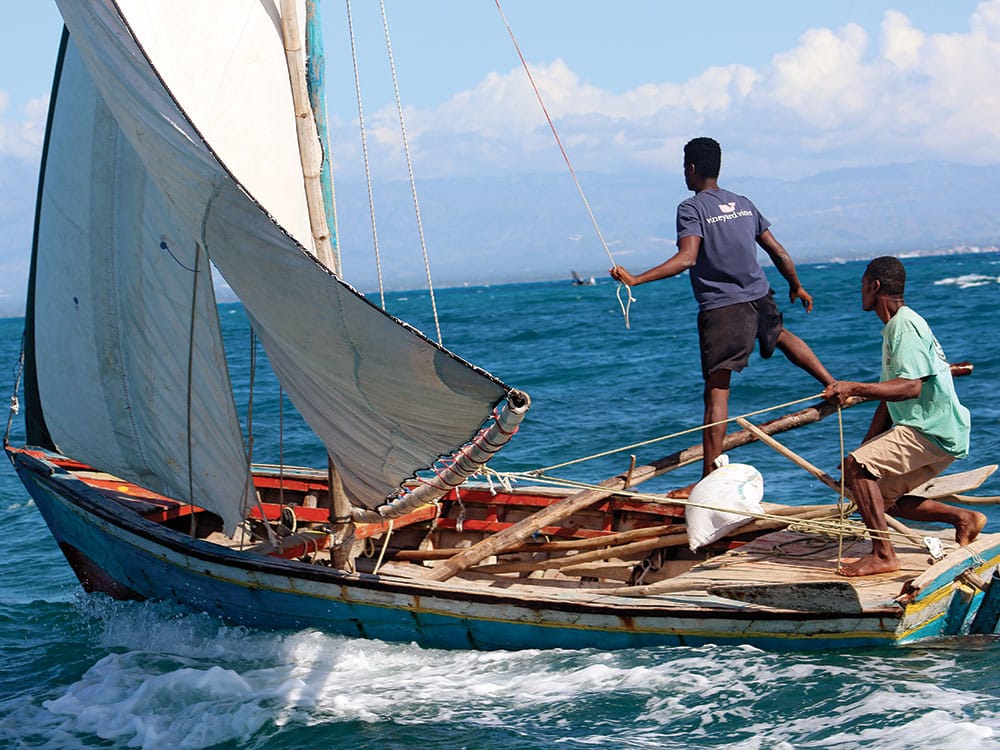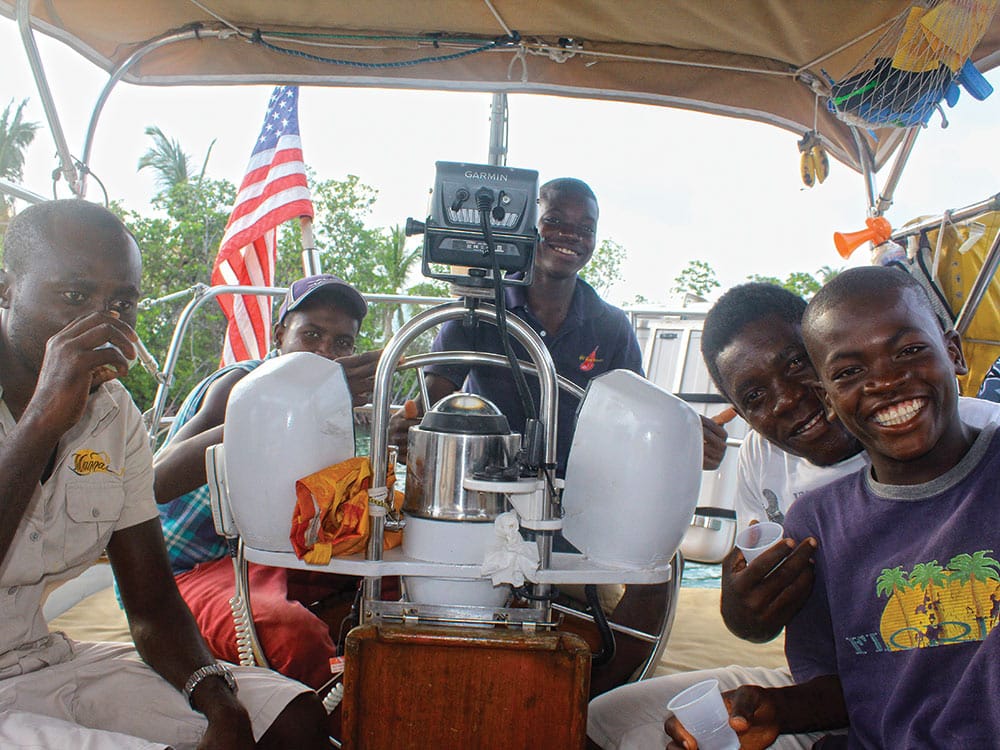
Approaching Haiti‘s southwest coast felt a bit like sailing through a time machine: Patched and threadbare gaffed sails dotted the horizon, with small crews handling their largely unballasted vessels with a skill that also belonged to another age — deftly weaving the vessels through the shallows while dodging each other and avoiding a minefield of fish nets.
If not for the fact that we were arriving in Haiti and not Tahiti, what greeted Symbiosis at Île à Vache (“Cow Island”) could have been a scene from Mutiny on the Bounty: Small dugouts, sometimes with nothing more than a broken palm frond for a paddle, rushed to meet us as we nosed into the coconut-fringed waters of Baie à Feret. Complicating matters, an engine problem meant that my wife, Noi, and I had to drop a tow from our friends aboard their trawler, Tropical Blend, and perform a dead-stick landing — all as we fended off entreaties from a dozen Haitian men clinging to the gunwales.
Just two months before, we had all but stricken Haiti from our itinerary. We had discussed the possible landfall with Debbie and Larry Gaddy on Tropical Blend, and decided, due to safety concerns that intuitively seemed greater after the devastation wrought recently by Hurricane Matthew, to head directly from the Dominican Republic’s south coast to Jamaica.
But a chance encounter in the British Virgin Islands changed everything.
In Virgin Gorda, we met a popular local musician who goes by the stage name Michael Beans. After enjoying a beach concert of Jimmy Buffett covers and pirate humor, we chatted up Michael (whose real surname is Gardener) and learned that he also runs the Good Samaritan Foundation of Haiti, an aid group with a focus on Île à Vache. By the end of the evening, Michael’s frenetic enthusiasm for Haiti and its people persuaded both crews to alter course and deliver for him a shipment of hurricane-relief supplies.
The next day, we loaded used sails, snorkel gear, children’s clothes, and other items aboard Symbiosis and Tropical Blend before leaving for St. Thomas, USVI, en route (as now was the case) to Haiti. In the following weeks, we issued an online call for donations to purchase supplies for Good Samaritan’s newly built primary school at Île à Vache. We managed to raise about $800 from friends and family, and bought dozens of notebooks, pencils, markers, glue, construction paper and soccer balls in Puerto Rico.
On our approach to Baie à Feret, we were hailed on VHF by Tandemeer, a 56-foot ketch run by the International Rescue Group, another Haiti charity. Skipper Sequoia Sun welcomed us to the island, provided us with some local knowledge on the best available anchoring spots and otherwise offered general assistance.
Once we’d finally dropped the hook (with help from Sequoia and fellow cruisers, who used their tenders to help get us set), Debbie began tossing out Tropical Blend‘s boat T-shirts like swag at a rock concert. A few old fishing poles came out of the holds of each boat and were quickly snapped up by outstretched hands.
No one was rejecting the handouts, but nearly everyone was also politely asking, in French, for a small boat job. We really didn’t need anything done (except for fixing the engine!), but along with the Tropical Blend crew, found a few make-work projects. Ernst, 15, wanted to clean the decks. He spent the next several hours removing rust stains from our anchor chain and stanchions that we’d all but given up on. He did a wonderful job. Now, what to pay him? We eventually learned that $5 is considered a very good daily wage. We paid $10.

Haiti — especially the southern part, which itself comprises the western tip of Hispaniola — was smashed by Matthew in October 2016. The storm wiped out 90 percent of the crops and livestock. But it hit the country of 11 million as it was still reeling from an earthquake that occurred seven years earlier, killing tens of thousands of people and leaving far more homeless. That has meant that places such as Île à Vache are relying even more heavily on the sea to stay alive. Fishermen, with their engineless boats, are in desperate need of old sails. Besides those we brought with us, Symbiosis managed to rip a very old 150 percent genoa as we were making our way to Haiti, and it was an easy decision to simply add it to the giveaway inventory. After a few days at Baie à Feret, Larry and Debbie needed to press on. We stayed behind, dealing with our engine problems, which turned out to be dirt in the tank and an air leak in the fuel line. That gave us some extra time to get to know the place. I’ll admit that there were times when the seemingly never-ending pleading from the “boat boys” got old, especially, in my case, when I was down below trying to solve the engine problems. But we also enjoyed their company and learned a bit about their lives.
Always-smiling Ernst had come to live with his cousin, Mark, at Île à Vache in hopes of earning something from cruisers in the bay. Davey makes a bit of money digging a long uphill trench for a well project sponsored by IRG. Kiki, much older, worked as a bartender in a local Western-owned hotel. But, with few guests, he was trying to make ends meet by plying the bay in his off hours. Kiki’s ambition is to earn enough money to get to Chile, where he hopes he can find real work and a better life.
It’s worth noting that we never had any safety or security concerns either at Île à Vache or nearby Les Cayes on the mainland. In our week in the anchorage, nothing was ever taken from the boat, which is more than we can say for some places we’ve visited that enjoy better reputations than Haiti.
We also befriended the tightknit cruising community at Île à Vache. Besides Sequoia and his temporary crewmates, John and Christina, we met John and Danielle aboard Joda and reconnected with Joanna on the catamaran Bamba Maru, whom we had met (along with boyfriend Andy) months earlier in Luperon, Dominican Republic. Joanna and Andy were now helping a local pastor with relief efforts.
With our tanks clean, the engine running, and an acceptable weather window to get to Port Antonio, Jamaica, we were ready to shove off, leaving the island that we almost missed but that had instead become one of the high points of our Caribbean voyage.
On our last night, we invited the boat boys aboard for dinner. They made us promise to return “next year,” and we offered polite assurances that we would, knowing full well that Île à Vache for us was, in the best and most bittersweet senses of the phrase, a once-in-a-lifetime experience.








